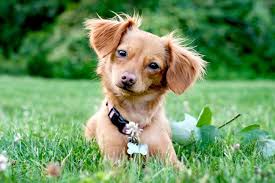Exercising a puppy can be as beneficial as it is challenging, and with a chini you are for a playful and sweet bundle of energy. A cross, Chinese, is known for its great personality and loyalty between Chihuahua and Dachshunds. Training of a Chinese puppy, but his enthusiastic nature can sometimes translate into a hard behavior so that proper exercise is needed.
A Chinese puppy training
This guide will run through the most important steps in training your Chinese puppy, from house interruptions through obedience and socialization. With patience and stability you will develop a foundation for a well -listed partner.
Understand your Chinese personality
Before training, you should familiarize yourself with unique symptoms of chinNney. These small dogs are a mixture of two breeds with extremely distinctive symptoms. Chihuahua is fist, and Dachshund is curious and difficult. Together you have a pride, sometimes there is a stubborn puppy that is the heart of gold.
Large symptoms to keep in mind:
Intelligence: Chiwewenies are intelligent and quick to take training, but also stubborn.
Energy level: They are moderate to high -energy dogs and require exercise on a daily basis to be cheerful.
Appendix: Chiwewenies join the owners and stay alone for several hours.
You know these symptoms to adjust your training methods for your personality and requirements.
Step 1: Potting training has mastered
Pot training should be the first part of your Chini training. These quick learning dogs contain small leaves, but they may require more frequent pot stops.
Tips for effective pot training
Determine a routine
Take the puppy out every time a day, such as waking up, eating and playing. Dogs love routine and prediction.
Select a specified area
Choose a specific potted location and bring your puppy there every time. The smell will help print the site in their brain where they will do business.
positive reinforcement
After completing your business, you reward and admire your puppy. Treating, a happy accent or a pet on the head performs miracles to strengthen positive behavior to a pet.
Monitor indoors
See the puppy carefully at home. If you show signs like sniffing or circling them, take them directly to the indoor pot area.
Pro Tip:
If you live in an apartment building or have bad weather, try training pot by using puppies. Eventually, your Chini is adjusted as an infection outside of pot training.
Step 2: Teaching in basic order
Basic orders such as “Sit”, “Stay” and “Come” form the basis for good etiquette and security. Early training allows your puppy to develop a basis for quick learning and complex training.
Command training steps
Start with “Sit”
Hold a cure in front of the puppy’s nose and lift it slowly upwards.
When you sit down by following the treatment naturally, say “sitting” at once and rewarding them.
Continue it for a few minutes each day until they react automatically.
Train “stay”
After learning his puppy to “sit”, sit them and then hold his hands and manage the “stay”.
Support one step and reward them immediately if they live in place.
Build slow distance and time in days.
Train “Come”
Play the game or call them from a distance from some stages.
Get down to their level, you open
Step 3: Socialization is important
Socialization is important to increase chiweenies for other corner, people and new environments. Without socialization at a young age, they can grow up with the development of fear or aggressive behavior.
How to socialize your puppy
Slowly introduce
Slowly introduce your chibenia to new surroundings, sounds and experiences. Parker, cafes or your neighborhood have a good starting point for walking around.
Set the puppy’s play dates
Plan ailments with other vaccination puppies for mutual interaction in harmony.
Sign up for puppy classes
Group classes are an excellent way to increase socialization, learn obedience orders.
Always monitor plate and ensure this a positive experience. If your puppy is aggressive or scared, leave them at peace and try again later.
Step 4: Barking and insulation problem
Barking comes from warnings, boredom or anxiety for insulation. To educate them when it will be worth it in the long term for bark.
How to reduce barking
Ignore extra barking
Do not reward barking with attention, positive or negative. Wait until they calm down before they talk.
Reduce attention
If they bark because they are bored, give toys or play a game.
Use “cool” or “adequate” command
Train a command like “cool” and reward them at the end of barking at the command.
For anxiety for insulation, start with little absence and gradually increase the time. Take the puppy together and introduce it to a familiar toy or blanket, and avoid goodbyes and notes from the noise.
Step 5: Enrich your Valprutinen
Chiweewenies are intelligent and energetic, so their brain and body should be stimulated. Otherwise, they will get bored and resort to unwanted behavior like chewing. If you have more
Training game
Include training in sports such as hiding or searching or exploration as an extra challenge.
Training your chair can cause its own injuries, but remember to think about, firmness and attitude always prevail. In fact, your disposition has an infinite number of resources, such as books, online training and professional instructors. Here is a link to Aspca’s puppy training guide for more specific advice.
Pick up a happy, well trained chiwenie
Exercising your Chiwenie puppy is an incredible way to create a strong bond and ensure that they grow in a well -listed partner. By focusing on routine, stability and positive reinforcement, you will be rewarded with a love, obedient and happy puppy.


